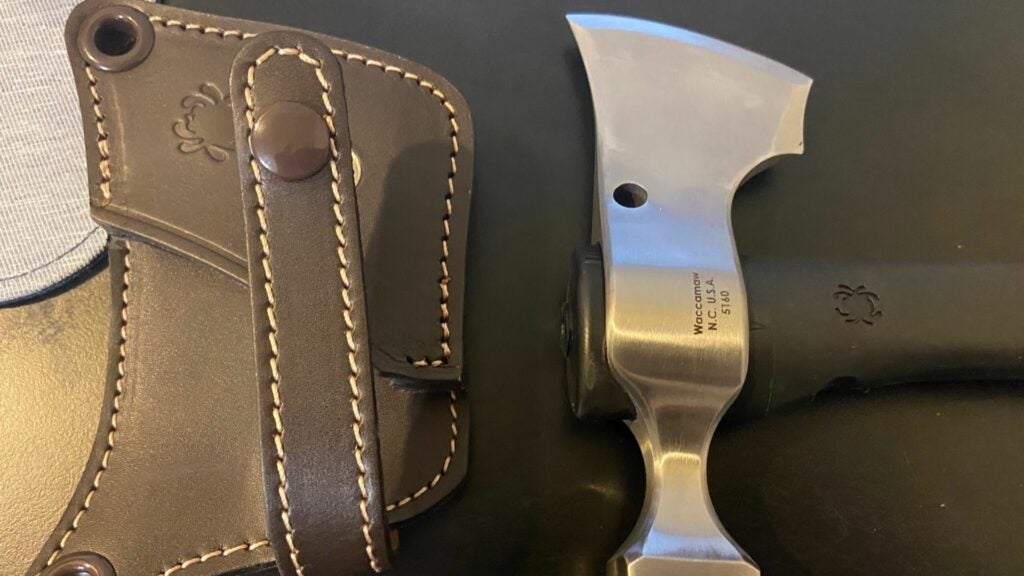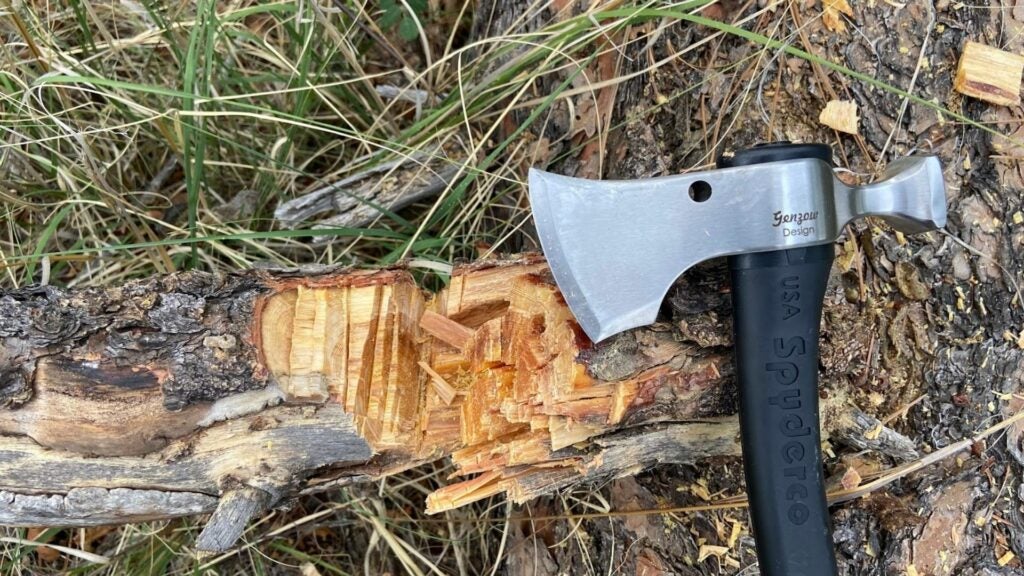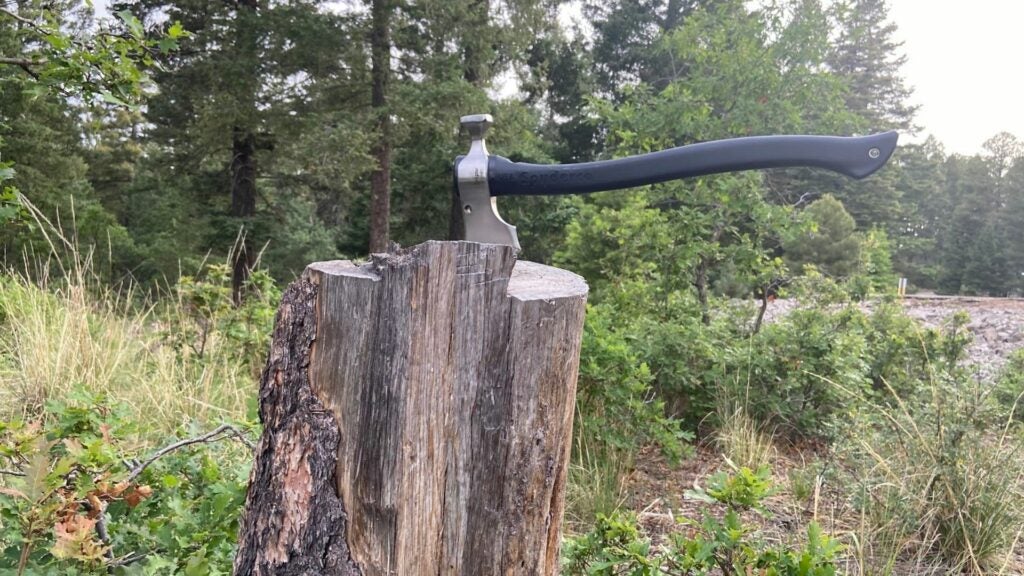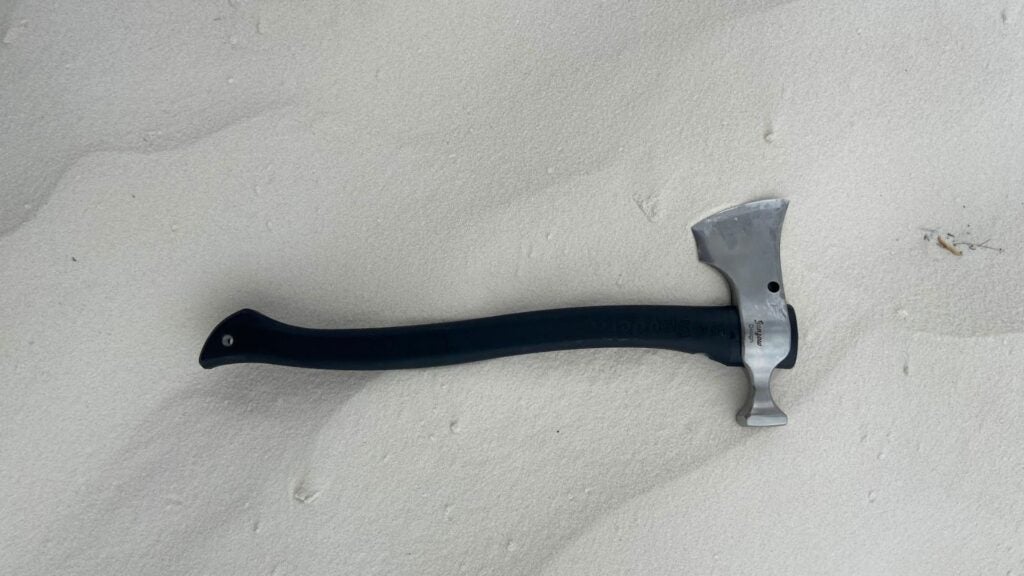An outdoor kit is rarely complete without a hatchet — a simple, short-handled axe to chop small pieces of wood into more manageable kindling for a fire or to build a small shelter. For U.S. military members, a hatchet can provide an incredibly useful tool for long stays in the field. A hatchet can help you build improved shelters to anchor your hooch to, or build spots for others to shade themselves from the heat. When I served at Fort Hood, I always threw a small hatchet into our company or platoon vehicles for use once we arrived at the training sights. I never carried one downrange, but in training it was one of those tools that can make life slightly better in the field. You can’t build a shelter strong enough to withstand a Texas rainstorm without some sort of hatchet.
Distinct from the hatchet is the tried-and-true tomahawk. The indigenous Algonquian people were one of the first peoples to employ a tomahawk on the battlefield. However, tomahawks are typically a strictly battlefield tool designed to be as light as possible for the fighter and to inflict lethal damage to their opponent. The edge of a tomahawk weapon should not be as big as a hatchet designed for chopping down trees.
Spyderco seeks to meld these two distinct hand-axes into one unique piece, the Spyderco Genzow HatchetHawk. But while the piece dazzles visually while hung on your wall or sheathed on your kit, it has issues in camp work mode; if this tool had a better handle, it would be one of the best tools to take with you on your next backcountry adventure.
Blade length: 6.14 in
Weight: 9.1 oz
Materials: 5160 tool steel (head), polypropylene/aluminum (handle)
Unboxing
Spyderco sent along a wonderfully packaged HatcherHawk that was truly exciting to pull out of the box. Inside a brown package, a triangular nylon pouch houses the hatchet. The pouch is lined with a soft fibrous cloth that could be used to polish the axe head, but serves as an elegant resting place when not in use. The hatchet comes with a high-end brown leather sheath that snaps into place with a belt loop. The accents on the leather sheath exude a luxurious but rugged appeal. The sheath is designed for heavy use as much as the HatchetHawk’s bit. Once unsnapped, the hatchet slips out of the sheath at an angle to maintain retention while carrying on your ruck or belt.

The HatchetHawk dimensions were perfect for my size. At 15.82 inches, the hatchet is the perfect length for use as both a hammer and a hatchet. The bit of the hatchet is made from extremely tough, heat-treated 5160 steel, sharpened to a razor sharp edge fresh out of the box. A small hole just behind the edge allows you to hang your hatchet in your shop, on a nail, or somewhere in your camp where you can always find it.
The hatchet’s sleek, curved handle creates a dual usage piece that allows the user to engage the hammer on the back of the hatchet. The handle itself is a polypropylene shell with an aluminum core that slightly protrudes from the bit. The shape of the handle is clearly designed to allow for maximum force transfer from the spot on the handle you grasp, to the axe or hammer part of the hatchet. When you flip it over, the hand falls naturally into place allowing for an extremely versatile camp tool. If the blade isn’t long enough to split a log, but you have a machete nearby, this tool would be a great force multiplier.
The axehead itself is nothing short of a work of art. It’s sleek, cascading design and combination of a bearded axe and a point at the tip make this tool ideal for chopping. When I tested it, the bit slams satisfyingly well into the wood on each stroke of the blade. The hammer portion, an often neglected portion of a small hatchet, is also extremely well-designed. This part of the hatchet could be used to mend fences, hammer nails, or assist you while splitting logs to further process for kindling. The curvature of the handle allows this versatile dual use to demonstrate the potential value of this piece. Unfortunately, It’s the materials of the handle that left us unimpressed.

How we tested the Spyderco Genzow HatchetHawk
Since this was an edged tool, I tested the blade’s sharpness to see exactly what this thing was capable of before I took it out to camp. The edge was surprisingly sharper than most knives you get fresh out of the box — it shaved the hair off my arm like a razor blade. It also slices through paper so exceptionally well that I was shocked. I frankly did not think that level of sharpness was required for a hatchet, but Spyderco thankfully sends them out at this high quality.
After testing and inspecting the hatchet for any flaws, I took the hatchet out to a campground in Cloudcroft, New Mexico over Memorial Day weekend. My first task was to chop up a felled tree in the area to gather some kindling for a campfire. I was able to make quick work of a few felled trees and stack a considerable amount of firewood in quick order. Next, I used the back side of the hatchet as a hammer to see if I could split a log with it.
The hatchet performed exceedingly well in the work it was intended for, but left much to be desired with comfort. Let’s get into the pros and cons of this piece, and whether it’s a good option for you.

What we like about the Spyderco Genzow HatchetHawk
First, the bit itself is the typical ultra-high quality you expect from Spyderco. I confiscated a Spyderco blade from a soldier in 2008 that was threatening to kill his roommate; I forgot that I had the knife and discovered it 10 years later as good as new without so much as speck of rust on any part of the blade. Spyderco continues to deliver high-quality materials, and the Genzow HatchetHawk is no different. The bit’s dual purpose of chopping wood or a useful camp hammer with an ergonomically designed handle make it feel comfortable in your hands, and also looks incredible.
The sheath on the hatchet is perfect in my opinion. It’s simple, attaches to your belt loop, and does not require any extra tooling to ensure it’s attached to your hip. The quality in this piece is just over the top in regard to its design and materials.
I love the shape of the handle and its dual purpose of both hammer and axe bit. The handle is curved for maximum force transfer for both sides of the tool, making it one of the most versatile camp tools on the market.

What we don’t like about the Spyderco Genzow HatchetHawk
Unfortunately, this piece has a pretty big design flaw: the aluminum core of the handle transfers every bit of the shock from the tip of the bit into your forearm and shoulder. From the second I swung the hatchet to when it landed, I could feel my hand tingle and the shock traveled all the way to my elbow. Despite this initial pain, I continued to swing as hard as I could for as long as I could to collect the wood for the fire. After collecting about four large branches from a felled tree, I had to stop due to the pain in my forearm. I’m right-handed, so I cannot switch hands safely with a large piece like this. Further, the tingling eventually traveled to my shoulder and I had to give up on my collection because it hurt so badly.
The hatchet has a nasty habit of also sending a sort of low intensity rumble that you can feel throughout your body when swinging it. It feels like when the dentist hits your tooth just a smidge too deep and touches a nerve, sending waves of pain over your body. This hatchet, despite all its extraordinary designs, included this fatal element. I was honestly saddened to realize how much pain the tool caused my body because it looks so nice out of the package.
Verdict
I sadly cannot recommend this product for purchase. The hatchet bit, shape, and ergonomic handle all come crashing down under the internal core of the hatchet. The packaging is amazing, and the design dazzles the user with a fresh aesthetic and an extraordinarily sharp blade. I’m doing my best to tell the story of this piece, because much like my military experience, I wanted to like this piece very much before it turned around and injured me. In particular, if you have nerve issues from upper back damage, this will only further exacerbate your injuries despite its satisfying action and appeal. Unfortunately, without a serious redesign of the handle, I cannot recommend that anyone use this.
I would like to see this extraordinary design re-hashed with a normal wooden handle or something that absorbs shock better than an aluminum piece. I simply cannot recommend this piece for use beyond hanging it on the wall.
FAQs about Spyderco Genzow HatchetHawk
More questions? Here’s Task & Purpose’s additional brief.
Q: How much does Spyderco Genzow HatchetHawk cost?
A: The Spyderco Genzow HatchetHawk costs $189.00.
Q. Who is Martin Genzow?
A. Martin Genzow is a German outdoor enthusiast with a long history and expertise in hatchet design. He was hired by Spyderco to assist in making something with the highest performance possible. It’s unfortunate the materials that were selected for the handle due to the extraordinary design by Genzow. Hopefully, Spyderco makes an improved model during their next phase of rollouts.
Q. Why would I need a hatchet?
A: A hatchet is one of the most useful tools one can have in their kit. As a soldier on patrol, there are rare times to use a hatchet. However, a hatchet can assist you to build all manner of shelter, fire, and cooking implements for a camp. If you are in the military, this is unlikely to be helpful; however, if you are a camping enthusiast, you almost cannot build a fire without one. You can, of course, purchase wood for a fire already processed, but if you intend to do any sort of primitive camping, you can’t go without a hatchet, or at the very least a saw, and I much prefer a hatchet over a small camp saw due to the convenience and how quickly you can accomplish the task.
Q. Can I just buy a tomahawk for this use?
A: No, tomahawks are for close-quarters combat in a war. When I served in combat, all my edged tools were for use and not combat. My weapon in combat was a rifle, a machine gun, a grenade launcher, or a light anti-tank weapon. I cannot fathom a time, even in the most intense firefights I participated in, where I thought “gee, I wish I had a tomahawk right now.” Modern combat consists of rockets and bullets, whereas a tomahawk is simply out of place in a conflict. I would argue that the combat application of this or any other hatchet as a tool should be the absolute last resort. Furthermore, this particular HatchetHawk is far too heavy to carry on patrol for such little use. Only once have I witnessed someone carrying something like that on patrol before it was taken and thrown over a bridge into the Saddam Canal.
Q. Why is the handle made of aluminum?
A: Spyderco wants to sell many of these units, and carving wooden handles for these axe heads would raise the cost to five times what this piece costs now. With the handle as it is, they can churn those out at a rate of hundreds per day, offering the piece for a much lower cost. This may be an impossible thing to accomplish, but the aluminum handle renders it useless for anything but a wall piece.
We’re here to be expert operators in everything How-To related. Use us, compliment us, tell us we’ve gone full FUBAR. Comment below and let’s talk! You can also shout at us on Twitter or Instagram.
Task & Purpose and its partners may earn a commission if you purchase a product through one of our links. Learn more about our product review process.
